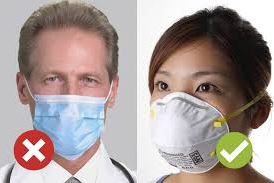What is a surgical face mask?
 |
| What is surgical mask |
A properly worn three-layer surgical mask can help block the transfer of large particles of microorganisms from droplets, sprays, sprays and sprays. A mask can also reduce the likelihood of face-to-face contact.
A three-layer surgical mask works as follows:
- The outer layer repels water, blood and other body fluids.
- The middle layer filters certain pathogens.
- The inner layer absorbs moisture and sweat from exhaled air.
However, the edges of the surgical masks do not form a tight seal around the nose or mouth. Therefore, they cannot filter out small particles in the air, such as those transmitted by coughing or sneezing.
When should you wear a face mask?
A reliable source from the World Health Organization (WHO) recommends using surgical masks only if you:fever, cough, or other respiratory symptoms
healthy, but caring for a respiratory illness - in this case, wear a mask when you are within 6 feet or closer to the patient
Although a surgical mask helps capture large respiratory drops, it cannot protect you from being infected with the new coronavirus, which is known as SARS-CoV-2. This is because surgical masks:
- do not filter out small particles in the air
- do not fit snugly on the face, so air particles can seep through the sides of the mask
- Some studies have not been able to show that surgical masks effectively prevent the effects of infectious diseases in society or in public places.
Currently, the Trusted Source of the Centers for Disease Control and Prevention (CDC) does not recommend that the general public wear surgical masks or N95 respirators to protect against respiratory diseases such as COVID-19. Health care providers and first aid providers need these materials and are currently in short supply.
However, in the case of COVID-19, the CDC advises the general public to wear fabric facings to prevent the spread of the disease. The CDC also provides Trusted Source instructions on how to make your own.
How to wear a surgical mask?
 |
| A proper way to wear a mask |
Steps for putting on a face mask
Before putting on the mask, wash your hands for at least 20 seconds with soap and water, or thoroughly wipe your hands with an alcohol-based hand sanitizer.
Check for mask defects such as tears or tear loops.
Place the color side of the mask out.
If available, make sure that the metal strip is on top of the mask and is opposite the nose bridge.
If the mask has:
- Earloops: Hold the mask by both earloops and put one loop on each ear.
- Ties: hold the mask by the upper strings. Tie the upper threads into a reliable bow near the crown of the head. Tie the bobbin thread securely at the nape of the neck.
- Double elastic bands: pull the upper tape over the head and place it on the top of the head. Pull the bottom ribbon over your head and place it on the back of your head.
- Give a bendable metal upper strip to the shape of your nose, squeezing and pressing it with your fingers.
- Put the mask on your mouth and chin.
- Make sure the mask fits snugly.
- Do not touch the mask once in position.
- If the mask becomes dirty or wet, replace it with a new one
